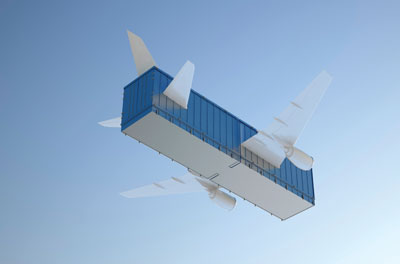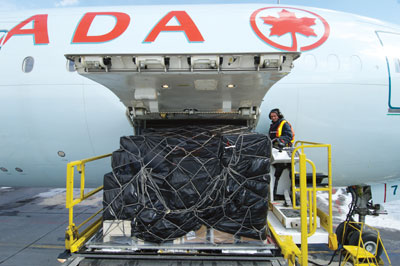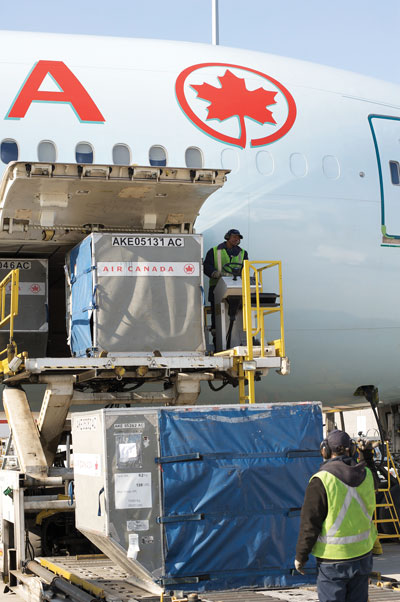
Features
Safety
Safe and Secure
While enhanced security measures at major North American airports have changed the face of commercial travel, new processes on the cargo side are also being implemented to ensure the highest safety standards possible.
May 10, 2011 By Brian Dunn
While enhanced security measures at major North American airports have changed the face of commercial travel, new processes on the cargo side are also being implemented to ensure the highest safety standards possible.
 |
|
| Securing cargo shipments continues to be a hot-button item for many airlines.
|
The changes at North American airports were accelerated by an incident two days before Christmas last year following word of al-Qaida’s air cargo bomb plot using insulated drinking mugs and thermoses. The U.S. Transportation Security Administration (TSA) responded to the incident by moving up its proposed 100 per cent cargo-screening target to Dec. 31, 2011.
The earliest possible implementation date for 100 per cent cargo screening in the U.S. was initially planned for 2013, given the complex challenges associated with screening international inbound cargo carried on passenger aircraft. But now, 100 per cent of the cargo that is uplifted on passenger aircraft headed south of the border must be screened by the end of this year.
All carriers will have 30 to 45 days to comment on the new 100 per cent screening requirement and the TSA will review and evaluate the industry comments prior to finalizing the requirement.
As to how this accelerated process will affect Canadian carriers, the “airlines are making the necessary adjustments in order to be compliant with the regulations. However, we cannot provide further details as this issue involves matters of safety and security, which must remain confidential in order to be effective,” says Brigitte Hébert, director, National Airlines Council of Canada.
According to TSA administrator John Pistole, the al-Qaida plot involved the use of triacetone triperoxide (TATP) around the cylinder of a thermos to be put on either passenger or cargo of an aircraft. Obviously, the outcome could have been catastrophic had the plot not been averted by the fast work of security personnel. “We put out an alert just making sure that all of our transportation security officers were alert to that and did additional physical screening in addition to the X-rays,” Pistole says.
As part of the standards in place, TSA evaluates and approves technologies that air carriers and Certified Cargo Screening Program participants may acquire to conduct screening operations.
To speed up cargo screening, 12 L-3 X-ray screening systems were placed on the TSA’s Air Cargo Qualified Technologies List. The L-3 screens are for both break-bulk and skid-based air cargo, with systems covering TSA’s small, medium and large X-ray classifications.
It’s all about the value
Although air cargo represents just two per cent of all international cargo shipped versus 98 per cent by sea, it accounts for 35 per cent by value, according to the International Air Transport Association (IATA). And cargo is expected to generate $68 billion of the industry’s projected $594 billion revenues in 2011. Volumes are projected to grow by 6.1 per cent for a total of 46.2 million tonnes of air cargo this year.
 |
|
| All cargo placed on an aircraft in Canada is currently 100 per cent secured prior to loading onto an aircraft. Photo: air canada |
“The air cargo value chain must offer better quality and improved efficiency with operations that are safer and even more secure,” says Giovanni Bisignani, IATA’s director general and CEO. “Our message to governments is clear. We must resist the knee-jerk call for 100 per cent cargo screening. The industry must be secure with effective measures that facilitate the speed needed to support global commerce. Air cargo security must be based on a combination of three measures – supply chain security, scanning technology and better use of e-freight data,” adds Bisignani.
IATA’s e-freight project began in 2004 and aims to take the paper out of air cargo. Facilitated by IATA, the project is an industry-wide initiative involving carriers, freight forwarders, ground handlers, shippers and customs authorities. Each air cargo shipment carries with it as many as 30 paper documents – enough to fill 80 Boeing 747 freighters every year. E-freight aims to take the paper out of the air cargo supply chain and replace it with cheaper, more accurate and more reliable electronic messaging.
E-freight data has huge potential, says Bisignani. For example, IATA has targetted 10 per cent e-freight volumes by the end of 2011, and 100 per cent by 2015. “The e-freight network covers 80 per cent of cargo volumes,” says Bisignani. “But e-freight penetration stands at just 2.8 per cent. Most governments have legislation that recognizes electronic documentation. The exceptions include Thailand, Indonesia, Russia and Vietnam, which much catch up fast or risk being left behind in this important business.”
The IATA e-freight program’s objective is to save the industry $4.9 billion by converting the 30-plus shipping documents and the processes behind them to electronic format. “It’s a no-brainer. If we can be faster, cheaper, more accurate and secure we need to get it done.”
Finding common ground
In Canada, air cargo security falls under the jurisdiction of Transport Canada (TC), which is working with the aviation and cargo industries to develop an Air Cargo Security Program (ACSP) that is compatible with that of the United States and other key international partners.
 |
|
| Cargo is expected to generate $68 billion of the industry’s projected $594 billion revenues in 2011, according to the IATA. PHOTO: air canada
|
“New security measures have been introduced to develop a secure supply chain for cargo using enhanced screening methods. The use of new screening requirements under the new measures is being phased in,” explains spokesperson Mélanie Quesnel of Transport Canada. But unlike the U.S., Canada does not have a specific date for 100 per cent cargo screening for inbound cargo, although all cargo placed on an aircraft in Canada is currently 100 per cent secured prior to loading onto an aircraft, according to Quesnel.
“While a form of screening has been used for a number of years, under the [Air Cargo Screening] Program announced in May 2010, a new standard will take place which considers factors such as the origin and destination of the cargo, the type of aircraft used (whether passenger or all-cargo), the contents, size/configuration and wrapping/packaging and sealing of the cargo.”
In terms of inbound cargo, TC is currently strengthening air cargo security by harmonizing inbound cargo requirements with international partners, including the U.S., European Commission and Australia, along with the International Civil Aviation Organization (ICAO) and IATA, says Quesnel.
The biggest obstacles to achieving 100 per cent cargo security are the complexity of the air cargo industry and the importance of the industry to the Canadian economy, says Quesnel. “Given the considerable volume, diversity of origins and destinations of air cargo, the physical size and contents of the shipments and the size and sophistication of companies sending cargo, air cargo security requirements are different from those in place for passenger or baggage screening. As well, the technology capable of screening (without unacceptable delay) varies based on the variety, quantity, and size of the air cargo.”
Simplifying the process
To reduce bottlenecks at airports, screening can now been done by shipper, freight forwarder or air carrier if they are ACSP participants. This eliminates the need for last-minute screening at airports, unless the pre-screened cargo appears to have been opened, screening is required for customs purposes (or for spot checks), it’s necessary for quality control or TC must inspect it.
In order for shippers and others to participate, ACSP created the Secure Supply Chain Management System (SSCMS) database. This database captures the information SSCMS participants must provide to become trusted members. It includes agent information, inspection and compliance results, and air cargo security templates.
Shippers and freight forwarders that choose not to participate in the ACSP program must have their air cargo screened by an ACSP participant or an air carrier to secure their cargo.
Each participant in the supply chain security system will accept, as secure, air cargo from the participant before them in the chain and will be responsible for keeping that air cargo secure until the next participant along the secure supply chain accepts it.
Last year, TC introduced changes to the regulatory framework for air cargo security in Canada that outline new requirements for airlines operating in Canada. These measures address security gaps and bring Canada in line with its international partners. The measures apply to domestic, trans-border and international passenger flights transporting screened passengers from Canada’s designated airports. Among other things, they require air carriers to secure all air cargo before loading onto the aircraft to the same level of security as that required for passenger baggage and to provide for adding specific measures for all-cargo flights.
But unlike airport screening, where passengers foot the bill, the cost for cargo screening equipment will be paid by airlines and shippers, not the airports themselves. How much that cost will be is still unknown, according to Cherif Rizkalla, president and chief commercial officer of Smiths Detection, the largest airport and cargo screening equipment company in the world with more than 2,500 employees and $1 billion in revenue. It has Canadian offices in Laval, Que., where Rizkalla is based, and in Mississauga, Ont.
“The regulations are still being defined, so the cost will depend upon Transport Canada regulations, which will be in line with other countries,” says Rizkalla.
In January, Smiths Detection, which spends eight per cent of its total revenue on research and development, was awarded a $19-million contract from the Canadian Air Transportation Security Authority (CATSA) to provide advanced X-ray machines at airports for carry-on bags, a process that provides multiple views of a bag’s contents. The company has more than 30 different screening models, the largest measuring 180 centimetres by 180 centimetres (six feet by six feet), for screening aircraft cargo pallets which can cost upwards of $300,000.
Rizkalla believes it’s possible to obtain 100 per cent cargo screening, but it will take time to implement. “It’s a realistic target, but not in the next few months,” he says. “All the airports in the world have 100 per cent inspection of baggage and yet there is a (cargo) package next to it that hasn’t been inspected. That is changing.”
A constant threat
While TC is working hard to implement security enhancements for cargo shipments, security measures for the transportation of dangerous goods have remained the same, says David Evans, manager of the transportation of dangerous goods at Purolator Courier in Mississauga. Dangerous goods are anything that could cause damage to an aircraft and include flammable liquids, acid and compressed goods.
“We’ve always been required to scrutinize dangerous goods before they’re loaded onto an aircraft,” says Evans. “They have to be documented so pilots know where they’re going on the aircraft. It’s been like that for the past 50 years.”
So, whether it’s the transportation of dangerous goods, regular cargo, commercial passengers or all three, authorities are attempting to make flying as safe as possible from the flight deck, through the aircraft and to the cargo hold.
| Joining forces International cargo security group takes aim at key issues The formation of a new international cargo security working group is an important step in the development of new standards for the industry. The Global Air Cargo Advisory Group (GACAG) was created in mid-March at the International Air Transport Association’s (IATA) World Cargo Symposium in Istanbul, Turkey. It brings together four key international organizations to discuss key cargo security and e-commerce issues – the International Federation of Freight Forwarders Association (FIATA); the IATA; The International Air Cargo Association (TIACA); and the Global Shipper’s Forum (GSF). The purpose of the working group is to establish a vision and strategy for the global air supply chain and to present joint industry recommendations to third parties, including intergovernmental organizations such as the World Customs Organization (WCO) and the ICAO. Each member organization will designate two representatives to the steering committee, who will direct, supervise and assist Task Forces of technical experts responsible for addressing GACAG’s objectives in relation to security, e-commerce, Customs and sustainability. Four key areas of discussion will be explored when it comes to Air Cargo Security:
The four founding members of the group included: Michael Steen, chairman of TIACA; Des Vertannes, Global Head of Cargo for the IATA; Jean-Claude Delon, president of FIATA; and Peter Gatti, executive vice-president of the U.S.-based GSF. In a joint statement, the heads of the four founding member Associations stated: “The high level of co-operation and commitment from all members has ensured a faster formation of the Global Air Cargo Advisory Group than was originally anticipated. We believe this reflects the need for such a strong industry-wide voice to address the challenges and opportunities facing everyone in the air cargo supply chain and, ultimately, businesses across the globe that rely on the speed, safety and efficiency of air cargo for their own growth and development. We are now ‘ready to go to work’ with a clear agreement on the prime areas we must focus on and the supporting structure to achieve our goals.” |